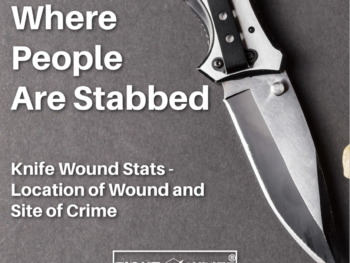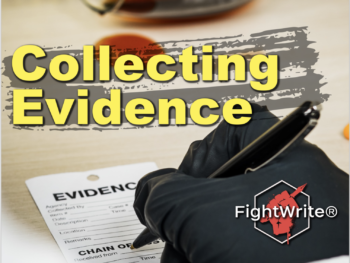The CSI Effect is the belief that TV crime shows are effecting the decisions of juries. Jurors have an expectation of what they will see brought into evidence because of the forensic evidence they see on CSI shows. In this series of posts, we will look at each type of evidence jurors expect to see. We will then look at issues associated with each type of evidence that you can add to your work to get your character off the hook. In this post, we will focus on blood pattern evidence.
Blood Pattern Evidence
Blood pattern analysis (BPA) seeks to answer three questions. Whose blood is this? How did it get where it is? What was the chain of events that created this blood pattern? More specifically, the analysis hopes to uncover the type of instrument used, who it was used on and from which direction the instrument was wielded. BPA also tries to recreate the position of the victim(s) and assailant(s) throughout the crime. It also helps law enforcement create more productive questions to ask witnesses and potential suspects as well as determine the truthfulness of any of their statements.
Stains vs. Spatters Blood Pattern Evidence
In the analysis of blood, there are stains and there are spatters. Stains occur as blood naturally flows in response to gravity. Blood stains can show how the victim moved as they bled because as the body changes position or orientation, blood will still flow toward the floor. Blood stains that break apart into smaller droplets because of an opposing force, other than gravity, are known as a spatter. If the spatter occurs from a moving force such a cough, or a wielded knife, it is considered projected blood spatter.
BPA Reliability Blood Pattern Evidence
The interpretation of blood pattern has an error rate of as much as 11% which may not seem like much until your child is one of the eleven of 100 wrongly imprisoned for life[i]. That error rate may be due to the fact that, in some areas, a mere forty-hour workshop can deem one able to interpret these patterns[ii]. And, as Professor Adrian Linacre, Chair in Forensic DNA Technology at Flinders University, Glasgow said, analysis of a blood pattern “is based upon the experience and knowledge of the examiner[iii].”
Blood Is Unpredictable Blood Pattern Evidence
Blood is not a predictable fluid like water. Water flows at the same rate regardless of how much is it stirred or shaken. Blood, however, is highly impacted by movement. The more it is moved, the thinner it is. That is why blood drips slow but sprays quickly[iv]. That is also why the higher the velocity of the spatter, the smaller the droplets.
Also, as soon as blood leaves the body it reacts to the ambient temperature. If the blood of your character lands on a cold wall, it will coagulate quickly and drip slower than it would on a warmer wall. Blood also reacts differently as it lands on different surfaces. If your character’s blood drops onto a smooth surface such as tile or glass, it will create a circular shape. If it strikes a surface that it not flat or it is not smooth, the droplet will break into smaller droplets.
If an assailant has cleaned an area of blood, its presence can still be detected with luminol even years after the blood has been present. Luminol is a powder that glows blue only when it contacts blood. The glow only lasts for about thirty seconds and can be captured with long-exposure photography. Luminol is used as a last resort as the same chemical reaction that detects blood also breaks the blood down.
Despite what you may see on screen, blue light does not detect the presence of blood. Blue light detects the presence of other body fluids such as urine and semen. Blood actually absorbs blue light and rather than glowing, shows up black[v]. So, when you see that in a movie, it is for theatrical purposes only.
In our next post, we will take a look at fingerprints. Until then, get blood on your pages!
[i] https://nij.ojp.gov/topics/articles/study-reports-error-rates-bloodstain-pattern-analysis
[ii] http://www.forensicpieces.com/lists/5-csi-and-recon-courses/items/450-basic-bloodstain-pattern-analysis
[iii] https://cosmosmagazine.com/science/bloodstain-pattern-analysis-explainer/
[iv] https://www.pbs.org/wgbh/nova/article/forensics-bloodstain-pattern-analysis/
[v] https://www.glogerm.com/pdf/Crime_blood.pdf











I am extremely inspired with your writing skills and also with the layout to your blog. Is this a paid subject or did you customize it your self? Either way keep up the nice high quality writing, it is rare to see a great weblog like this one nowadays..
Hello there, just became aware of your blog through Google, and found that it’s truly informative. I’m going to watch out for brussels. I will be grateful if you continue this in future. A lot of people will be benefited from your writing. Cheers!
Regards for this post, I am a big big fan of this website would like to keep updated.
you have a great blog here! would you like to make some invite posts on my blog?
It’s laborious to seek out knowledgeable people on this subject, but you sound like you recognize what you’re speaking about! Thanks
Well I sincerely enjoyed reading it. This information provided by you is very effective for correct planning.
I’ve read a few good stuff here. Certainly price bookmarking for revisiting. I surprise how much effort you place to make such a excellent informative website.
whoah this blog is fantastic i love reading your posts. Keep up the good work! You know, lots of people are hunting around for this info, you could help them greatly.
I am only commenting to make you understand of the superb discovery my friend’s girl undergone viewing your site. She figured out lots of details, most notably what it is like to have an excellent helping style to get men and women smoothly know precisely various complex things. You truly surpassed visitors’ expected results. I appreciate you for presenting those insightful, safe, edifying and also unique thoughts on the topic to Jane.
Hi , I do believe this is an excellent blog. I stumbled upon it on Yahoo , i will come back once again. Money and freedom is the best way to change, may you be rich and help other people.
I am so happy to read this. This is the type of manual that needs to be given and not the accidental misinformation that’s at the other blogs. Appreciate your sharing this best doc.
There is noticeably a bundle to know about this. I assume you made certain nice points in features also.
You can definitely see your enthusiasm in the work you write. The world hopes for even more passionate writers like you who aren’t afraid to say how they believe. Always follow your heart.
I think this web site holds some very great info for everyone :D. “Morality, like art, means a drawing a line someplace.” by Oscar Wilde.
I used to be very happy to search out this net-site.I wished to thanks for your time for this excellent learn!! I definitely enjoying every little bit of it and I’ve you bookmarked to take a look at new stuff you blog post.
Some really great information, Gladiola I observed this. “So long as little children are allowed to suffer, there is no true love in this world.” by Isodore Duncan.
I don’t unremarkably comment but I gotta state thanks for the post on this amazing one : D.
This web page is mostly a walk-by for all the data you needed about this and didn’t know who to ask. Glimpse right here, and also you’ll positively discover it.
What i do not understood is actually how you are no longer really much more well-preferred than you may be now. You are so intelligent. You understand thus significantly on the subject of this subject, made me in my opinion consider it from numerous varied angles. Its like men and women don’t seem to be involved unless it is something to accomplish with Woman gaga! Your individual stuffs great. All the time handle it up!
Whats up very nice site!! Guy .. Excellent .. Wonderful .. I’ll bookmark your blog and take the feeds also?KI’m happy to seek out numerous useful info here in the put up, we want develop more techniques on this regard, thanks for sharing. . . . . .
Very interesting information!Perfect just what I was searching for!
I just couldn’t go away your website before suggesting that I really loved the usual info a person supply in your guests? Is going to be again steadily in order to check up on new posts